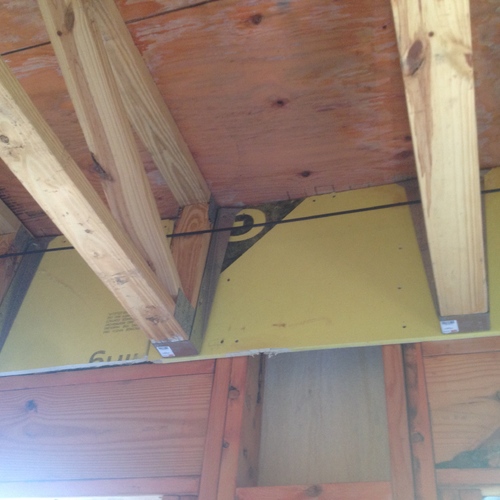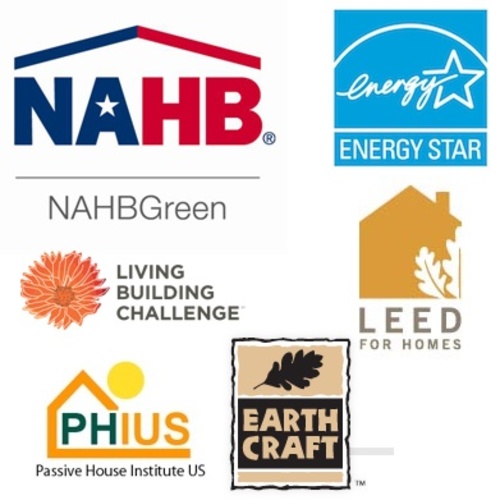Image Credit: City of Decatur
Image Credit: City of Decatur One example of the city logo is seen on directional signs all through town.
Image Credit: Carl Seville You can't talk about Decatur without mentioning the BrickStore Pub — one of the best beer bars in the country.
Image Credit: Carl Seville
The city I live in, Decatur, Georgia — a great, if possibly overly gentrified, place to live — recently passed a unified development ordinance (UDO) requiring green building certification for all new buildings and most renovations — both residential and commercial.
I was pleased to be part of the team that worked on this, mostly on the residential side, helping the city staff understand what was required by the various programs they were considering. I also took part in several stakeholder meetings and testified in favor of the ordinance before the city commission prior to their vote.
You can read the green building portion of the ordinance here.
Resistance was futile
Luckily for those supporting the ordinance, there was no organized counteroffensive. In fact, at the last meeting I attended, five people spoke in favor of the new requirements and no one spoke against them.
The current plan is for the ordinance to go into effect in late 2015, with a slightly longer timeline for the renovations to allow the city to determine the economic impact.
There was some legitimate concern about what scale of renovation would require green certification. The city’s definition of “substantial improvement,” the point at which the green standards would kick in, is “any combination or repairs, reconstruction, alteration or improvements to a building where the cost of the construction exceeds 50% of the fair market value of the structure prior to improvement.” The definition goes on to describe how to determine fair market value.
A group of us suggested that certification be required for any home adding 1,000 square feet of new space or more, or gutting 50% of the interior or exterior walls. This was shot down by the planning staff as conflicting with the existing definition of substantial improvement.
It remains to be seen how it will work out. Our goal was to require major renovations to meet green certification but not force it on small projects where the increased costs might be prohibitive. My personal opinion is that every project, no matter how small, should meet some level of sustainable/high performance/green/whatever you want to call it construction, but I can be a bit of an extremist and am willing to compromise occasionally.
Down to the nuts and bolts
As I don’t do much with commercial construction, I will leave the details of that to others, but as to the residential requirements, I believe we came up with comprehensive requirements that are achievable without significant cost implications (at least compared to code-compliant high-quality construction; those who consistently produce substandard buildings will be a bit more challenged.)
The ordinance appropriately separates one- and two- family homes from multifamily construction. One- and two-family projects and multifamily low-rise buildings up to three stories, whether new or involving substantial renovations, must meet one of the following certifications:
• NGBS Silver
• LEED for Homes
• EarthCraft House, Renovation, or the new Sustainable Preservation program
Mid-rise and high-rise multifamily, whether new or involving substantial improvements, must meet one of the following certifications:
• NGBS Silver
• LEED for Homes or LEED BD+C
• EarthCraft House, Multifamily, Light Commercial, or Sustainable Preservation
• Green Globes Three Globes
In addition, each project must meet an airtightness threshold of 5 ACH50, or an envelope leakage ratio (ELR50) of 0.33 cfm50/sq. ft. of building envelope if the building has less than 1,500 square feet of finished space.
We offered the ELR50 option because we have found that small units often have trouble meeting ACH50 requirements even when they are as tight as or tighter than larger buildings. Since ELR50 more accurately reflects the amount of leakage through the building envelope, it does not favor large volume buildings the way ACH50 does.
Air leakage sampling is allowed in multifamily buildings at a rate of 25% of all units, or the RESNET protocol (1 in 7) may be used if the testing is completed by a HERS rater. Renovation projects are only required to meet the 7 ach50 requirement found in the Georgia (and 2009) energy code.
Leakage testing must be done on all duct systems that extend outside the building envelope as per the 2009 IECC.
Venting about ventilation
One- and two-family homes must have a whole-house mechanical ventilation system installed. The ventilation system must be verified in the field as complying with ASHRAE 62.2-2010; exhaust-only systems cannot be used to meet these requirements. (In our mixed humid climate, exhaust-only ventilation is discouraged to help keep moisture out of building cavities.)
Also, bath and kitchen exhaust fans must meet 62.2 and be vented to the exterior. Thankfully, no more recirculating fans are allowed, except in kitchens on multifamily projects.
The typical ventilation system in Georgia has an outside air intake ducted to the HVAC return plenum. This is an effective but often poorly installed method. ERVs are sometimes used; however, they can be costly and I personally doubt their value in our reasonably moderate climate. We have a way to go in effective implementation of whole house ventilation in the field.
On a positive note, whole-house ventilation in single- and two-family homes requires labeled and occupant accessible override controls. However, this system must reset itself and cannot be set to provide less than 10% of the ASHRAE requirement. Since I personally only use my ERV very infrequently, I have some difficulty with this requirement, but it’s not a bad start.
Exceptional exceptions and enforcement
To help out in potential hardship situations, the city may issue exemptions from any requirements, provided the applicant demonstrates one of the following criteria:
• Certification and verification costs would exceed 10% of construction costs
• The building is historic or in a historic district, and the local preservation commission has denied the required approval due to negative impact on the historic nature of the building
• The building is historic or eligible for the National Register and complying with the requirements would jeopardize the historic nature or inclusion in the register.
It remains to be seen how the certification requirements will be enforced. Early on there was some discussion about requiring a cash bond at the time of permitting, to be returned at the time of certification; however, that provision does not appear to have made it into the final ordinance. I am concerned that if there is not some significant incentive to complete certification, we may see many non-compliant buildings coming on line.
Another city nearby theoretically requires EarthCraft certification for all new homes; however, based on my experience with some builders there, the inspectors are providing certificates of occupancy for many buildings that do not complete the certification process.
How hard will this be?
One my tasks during the development process was to look at what it would take to meet NGBS certification for some typical projects. I spent some time going through the program worksheet, noting where points were easily obtained, which path (prescriptive or performance) was most appropriate, and what was common code-compliant and high-quality construction.
Since Decatur is a very walkable community, many of the location and site points were very easily obtainable. As Georgia already requires blower-door testing, those points were available as well. Once we considered standard manufacturer’s requirements (such as Grade 1 insulation quality) and other code requirements (Manual J for HVAC equipment sizing), we determined that there was minimal if any additional cost, other than the verification and certification fees, to meet most program requirements.
As I noted earlier, substandard builders will be more challenged to meet the requirements, but it is not a difficult learning curve and the whole team that worked on this ordinance is excited about living in a community that encourages (and requires) high-performance construction. We know we aren’t pioneers, but given that we are in the deep South, I think we did pretty well.
Decatur High Performance Building Ordinance
Weekly Newsletter
Get building science and energy efficiency advice, plus special offers, in your inbox.
















8 Comments
which way do they lean
There's sort of a hilarious implication through this -- that "blue"
actually pays attention to this stuff, and folks in the "red" camp
don't care one whit about how much energy gets wasted. Now, which
end of that spectrum is more, uh, "patriotic american"??
In those climates, how well do ERVs really work in the stupidly-muggy
summer weather, or does the setup for incoming air getting dumped
right into the cooling system to get dried out compensate for that
well enough? I've only got an HRV here but there are times when I
don't want to run it at all in certain outdoor conditions and when
the house *doesn't* need active cooling.
_H*
good article
The only thing that is troublesome is the whole house ventilation requirement. Complicates installation of a mini split and other options. The certification required or just the standards of those certifications? Think actual performance based results would have been better. If the house uses less x percentage than the median house then it passes. Also small house should be not on the same requirements because, by being smaller they are greener.
Agree on the ventilation
SE - Glad you enjoyed it. I tend to agree on the ventilation issue. I have long standing problems with ASHRAE 62.2 requirements, as do many in the industry. Everyone either thinks its too much or too little, which, I believe it pretty much the truth for most people.
As to the certification issue, they ordinance currently requires certification, not just meeting the criteria. I believe this is the best route, since having a 3rd party involved provides some measure of quality control. The city doesn't have the capacity to police the level of performance the programs require, and while the quality of 3rd party verifiers varies, at least its a start towards some consistency.
Regarding your last point about performance based- that might work if the ordinance was only addressing energy, rather it requires green building certification, including air quality, material use, and all the other pieces of the puzzle.
Your suggestion of passing a house based on performance is similar to the living building challenge, requiring a year of operational data before certification. In this case, we need simple, agreed upon criteria for everyone to follow. It remains to be seen how it will be enforced and what changes will come down the road.
To Hobbit - Atlanta is actually a fairly moderate climate - we have many fewer stupid muggy summer days than you might think. During typically national heat waves, the temperature is usually cooler here since we are about 1000 feet above sea level. It's not quite the deep south.
Response to S E
The whole house ventilation requirement meets the 2012 IRC sort of... Adding a mini-split would likely not kick in the ventilation requirement anyway.
In Charlotte there is decent housing stock available for about $50K. These homes are in very bad neighborhoods. The requirement of 50% of fair market value improvements kicking in the efficiency requirements could possibly delay revitalization of those neighborhoods. But even then I'm not so sure. That would be $25K of improvements which for the size of those houses would be large improvements anyway. That would be beyond refinishing the floors, or replacing the HVAC system, or the roof, or even doing all of those at the same time, heck you could probably sneak a decent basic kitchen remodel in there as well.
At the same time it would also make teardowns more likely, renovations are already more expensive per sq ft than new construction. For a house that requires extensive renovations, this pushes the metric of tear down vs renovate more towards the tear down side. Those homes represent a lot of embodied energy that may have a very long payback time if they get replaced with new construction. That may be a bit of a red herring argument as well, as most of the tear downs I am familiar with happen because the owner wants the new house, and most of the renovations I am familiar with happen because the owner likes the existing house but needs to improve it in some way.
ACH50 and applause
I find it interesting that a green building ordinance calls for an ACH50 level greater than the last two model energy codes.
But the bigger point here is that a community has decided to set a floor for sustainability. That's something that is long overdue in our country.
Carl, I applaud your efforts and the city's decision to move in a greener direction!
Response to Mike
Mike - IECC2009, the current code in Ga (CZ 3) , requires ACH50 of 7, so we are requiring better than that with 5. If and when we adopt the 2012 IECC, and they keep the 3ACH50 requirement, that will supersede the city code. I'm glad we got something started and look forward to seeing how it evolves.
NYS requires this for new
NYS requires this for new state owned projects
Response to AJ Builder
AJ,
You forgot to tell us what "this" is.
Log in or create an account to post a comment.
Sign up Log in